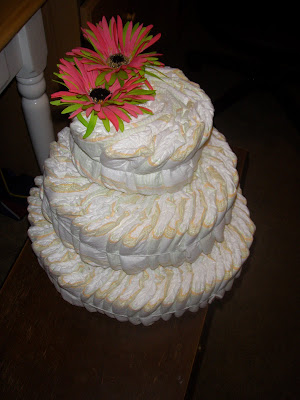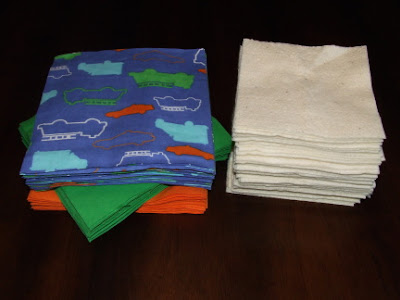 I made these for my kids for Christmas and they loved them! These would also make cute personalized birthday presents. They are so simple and fun to make, you might get addicted like I have!
I made these for my kids for Christmas and they loved them! These would also make cute personalized birthday presents. They are so simple and fun to make, you might get addicted like I have!You should already have most of the stuff. Here's what you will need for one standard size pillowcase:
1/4 yard white fabric- I prefer 65 poly/35 cotton blend. It's really cheap and holds up well.
up to 1 and 1/4 yard patterned fabric- So far I have chosen licensed prints for my kids, but anything will do. Read my note* before buying your fabric.
small piece of freezer paper- you can buy a roll at Wal-mart in the foil and baggie section.
 fabric paint- I like Tulip brand. It goes on nice and thick and I rarely need more than one coat.
fabric paint- I like Tulip brand. It goes on nice and thick and I rarely need more than one coat.X-acto knife
piece of leftover cardboard
paintbrush
cutting mat and rotary cutter
sewing machine
thread
iron/ironing board
One thing to note is that you want the pattern on the fabric to appear horizontal after the pillowcase is sewn. The last thing you want is your Care Bears looking sideways. How much fabric you will need will depend on how the pattern comes off the bolt. For example, if the pattern comes this way, you will need 1 and 1/4 of a yard.
 You will need 3/4 of a yard if the fabric comes off the bolt like this...
You will need 3/4 of a yard if the fabric comes off the bolt like this... The reason for this is that we are going to cut one large piece that will be folded at the top. Once folded, we will have the horizontal patterned piece of the pillowcase. We want it to look like this:
The reason for this is that we are going to cut one large piece that will be folded at the top. Once folded, we will have the horizontal patterned piece of the pillowcase. We want it to look like this: So keep that in mind while buying and cutting your fabric. If the fabric you have chosen can face either way or doesn't have a distinct horizontal pattern to it, you can just buy 3/4 of a yard.
So keep that in mind while buying and cutting your fabric. If the fabric you have chosen can face either way or doesn't have a distinct horizontal pattern to it, you can just buy 3/4 of a yard.That's it! Let's start. Set up your ironing board and plug in your iron. We will be using a 1/4 inch seam allowance for the whole project.
Cut a 26.5 x 38.5 piece from your patterned fabric. Set that aside.
Cut an 8.5 x 38.5 piece from your white fabric.
Fold the white piece in half longways and press; then fold it in half the other way and press. Now you know where the center is.
Get on your computer and find a cute font to print out your kid's name with. If you don't have any fonts you like on your computer, go to Kevin and Amanda's free fonts site and you're sure to find something cute. Open up a word document and enlarge your name so that it's no taller than 4 inches. That includes tall letters like lower-case d, h and l. Go to format in the menu bar and then choose character and chose the outline feature. That way when you print out the name, you won't use up your whole ink cartridge; it will just print a nice outline for you. Like so:
 Trace the name onto a piece of freezer paper with the shiny side down. Using your X-acto knife and cutting mat, cut out the letters on the paper. Try not to make any extra slices because the fabric paint will end up seeping out of the stencil. Don't forget to keep any inside pieces like the loops in the letters e, p and d. You will need them! For really great and thorough instructions for freezer paper stenciling, check out Dana's tutorial at Made.
Trace the name onto a piece of freezer paper with the shiny side down. Using your X-acto knife and cutting mat, cut out the letters on the paper. Try not to make any extra slices because the fabric paint will end up seeping out of the stencil. Don't forget to keep any inside pieces like the loops in the letters e, p and d. You will need them! For really great and thorough instructions for freezer paper stenciling, check out Dana's tutorial at Made.  Center the stencil onto one side of the white fabric and then iron it on. Note: If you want the name to appear on a certain side of the finished pillowcase (right or left) you will need to put the small fold up and the long fold at the bottom of the name. For example, for the name to be on the left side of the pillowcase, you will place the name here:
Center the stencil onto one side of the white fabric and then iron it on. Note: If you want the name to appear on a certain side of the finished pillowcase (right or left) you will need to put the small fold up and the long fold at the bottom of the name. For example, for the name to be on the left side of the pillowcase, you will place the name here: The fold of the fabric should always be underneath the name. There will be no seam allowance on the fold, so you can place your name as close to the fold as you like. I like to keep in about 1/4 of an inch or more from the fold. If you want it centered from top to bottom, just remember that there will be 1/4-inch seam allowance on the top.
The fold of the fabric should always be underneath the name. There will be no seam allowance on the fold, so you can place your name as close to the fold as you like. I like to keep in about 1/4 of an inch or more from the fold. If you want it centered from top to bottom, just remember that there will be 1/4-inch seam allowance on the top.Place the cardboard under the fabric so that paint won't seep onto the rest of the fabric. Paint on a nice layer of fabric paint and let it dry for 3-4 hours. If you think it needs another layer of paint, go ahead and do that and let it dry again.
When the paint is dry, peel off the freezer paper. Doesn't it look pretty? Cover it with scrap fabric and press for a few minutes. Make sure to fold the white fabric lengthwise again if you unfolded it during the painting process. Now put the white and patterned pieces together (the matching 38.5 length sides), right sides together, (raw side of the white) and pin well. The name will be hidden as you sew.

 Sew the 38.5 inch length (remember all seam allowances will be 1/4 inch). Zig zag over the seam allowance. Now iron that seam up towards the colored fabric.
Sew the 38.5 inch length (remember all seam allowances will be 1/4 inch). Zig zag over the seam allowance. Now iron that seam up towards the colored fabric. We're going to topstitch on the colored fabric just above the seam line, a little less than 1/4 inch so as to catch seam allowance underneath that we just ironed up. Not perfect, but it's okay!
We're going to topstitch on the colored fabric just above the seam line, a little less than 1/4 inch so as to catch seam allowance underneath that we just ironed up. Not perfect, but it's okay! Almost done! Can you believe how easy these are? Now fold the pillowcase in half, right sides together, pin it well and sew it closed. I start sewing where the white fabric is to keep it even. Zig zag your seam allowance. Inside it out and press. And you're done!
Almost done! Can you believe how easy these are? Now fold the pillowcase in half, right sides together, pin it well and sew it closed. I start sewing where the white fabric is to keep it even. Zig zag your seam allowance. Inside it out and press. And you're done!










































